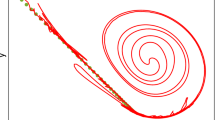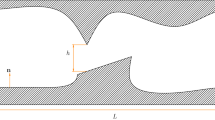Abstract
The paper presents a method to evaluate near-singular boundary integrals in axi-symmetric interfacial Stokes flow for target points close to but not on the interface. The method consists of appoximating the integrand by a function with analytically available integral and numerically approximating the difference by a standard 4th-order trapezoidal rule with uniform mesh size h. The resulting correction is applied to all points at distance d sufficiently close to the boundary. The maximum errors are reduced from order O(h/d) to \(O(h^m)\), where m depends on the number of terms in the approximating function. The paper presents all necessary details in the axi-symmetric Stokes case, implements specific \(O(h^2)\), \(O(h^3)\) and \(O(h^4)\) versions, and shows that the analytically predicted convergence rates are attained for sample test cases. The method is applied to compute the evolution of double emulsions through a tapered nozzle and shown to resolve the unphysical tangling of interfaces that occurs with standard quadratures.
Similar content being viewed by others
References
Abramowitz, M.: Handbook of Mathematical Functions: With Formulas, Graphs, and Mathematical Tables. Dover Publications, New York (1974)
Anna, S.L.: Droplets and bubbles in microfluidic devices. Annu. Rev. Fluid Mech. 48, 285–309 (2016)
Barnett, A., Wu, B., Veerapaneni, S.: Spectrally accurate quadratures for evaluation of layer potentials close to the boundary for the 2d Stokes and Laplace equations. SIAM J. Sci. Comput. 37(4), 519–542 (2015)
Barnett, A.H.: Evaluation of layer potentials close to the boundary for Laplace and Helmholtz problems on analytic planar domains. SIAM J. Sci. Comput. 36(2), A427–A451 (2014)
Beale, J.T., Lai, M.C.: A method for computing nearly singular integrals. SIAM J. Numer. Anal. 38(6), 1902–1925 (2001)
Beale, J.T., Ying, W., Wilson, J.R.: A simple method for computing singular or nearly singular integrals on closed surfaces. Comm. Comput. Phys. 20, 733–753 (2016)
de Bernadinis, B., Moore, D.W.: A ring-vortex representation of an axi-symmetric vortex sheet. In: Hussaini, M.Y., Salas, M.D. (eds.) Studies of vortex dominated flows, pp. 33–43. Springer, New York (1987). https://doi.org/10.1007/978-1-4612-4678-7_3
Bystricky, L., Palsson, S., Tornberg, A.K.: An accurate integral equation method for stokes flow with piecewise smooth boundaries. Bit Numer Math 61, 309–335 (2021)
Carvalho, C., Khatri, S., Kim, A.D.: Asymptotic analysis for close evaluation of layer potentials. J. Comp. Phys. 355, 327–341 (2018)
Chen, H., Li, J., Shum, H.C., Stone, H.A., Weitz, D.A.: Breakup of double emulsions in constrictions. Soft Matter 7, 2345–2347 (2011)
Cortez, R.: The method of regularized Stokeslets. SIAM J. Sci. Comput. 23(4), 1204–1225 (2001)
Epstein, C.L., Greengard, L., Klöckner, A.: On the convergence of local expansions of layer potentials. SIAM J. Numer. Anal. 51(5), 2660–2679 (2013)
Guo, H., Zhu, H., Liu, R., Bonnet, M., Veerapaneni, S.: Optimal slip velocities of micro-swimmers with arbitrary axisymmetric shapes. J. Fluid Mech. 910, A26 (2021). https://doi.org/10.1017/jfm.2020.969
Helsing, J., Ojala, R.: On the evaluation of layer potentials close to their sources. J. Comp. Phys. 227, 2899–2921 (2008)
Hou, T., Lowengrub, J., Shelley, M.: Removing the stiffness from interfacial flows with surface tension. J. Comp. Phys. 114, 312–338 (1994)
Jensen, M.J., Stone, H.A., Bruus, H.: A numerical study of two-phase Stokes flow in an axisymmetric flow-focusing device. Phys. Fluids 18(077), 103–285 (2006)
Khatri, S., Kim, A.D., Cortez, R., Carvalho, C.: Close evaluation of layer potentials in three dimensions. J. Comp. Phys. 423, 109,798 (2020)
Klinteberg, L.A., Tornberg, A.K.: A fast integral equation method for solid particles in viscous flow using quadrature by expansion. J. Comp. Phys. 326, 420–445 (2016)
Klinteberg, L.A., Tornberg, A.K.: Error estimation for quadrature by expansion in layer potential evaluation. Adv. Comput. Math. 43, 195–234 (2017)
Klinteberg, L.A., Tornberg, A.K.: Adaptive quadrature by expansion for layer potential evaluation in two dimensions. SIAM J. Sci. Comp. 40(3), A1225–A1249 (2018)
Klöckner, A., Barnett, A., Greengard, L., O’Neil, M.: Quadrature by expansion: A new method for the evaluation of layer potentials. J. Comp. Phys. 252, 332–349 (2013)
Ladyzhenskaya, O.A.: The boundary value problems of mathematical physics. Springer, New York, NY (2010). https://doi.org/10.1007/978-1-4757-4317-3
Lee, S.H., Leal, L.G.: The motion of a sphere in the presence of a deformable interface. II. A numerical study of a translation of a sphere normal to an interface. J. Colloid Interface 87, 81–106 (1982)
Marin, O., Runborg, O., Tornberg, A.K.: Corrected trapezoidal rules for a class of singular functions. IMA J. Numer. Anal. 34(4), 1509–1540 (2014)
Nie, Q., Baker, G.: Application of adaptive quadratrue to axi-symmetric vortex sheet motion. J. Comp. Phys 143, 49–69 (1998)
Nitsche, M.: Axisymmetric vortex sheet motion: accurate evaluation of the principal value integrals. SIAM J. Sci. Comput. 21(3), 1066–1084 (1999)
Nitsche, M.: Singularity formation in a cylindrical and a spherical vortex sheet. J. Comput Phys. 173(1), 208–230 (2001)
Nitsche, M.: Evaluation of near-singular integrals with application to vortex sheet flow. Theoretical and Computational Fluid Dynamics pp. https://doi.org/10.1007/s00162-021-00577-9(2021)
Nitsche, M.: Axisymmetric stokes flow - near singular integrals. (2022). https://github.com/monikanitsche/axistokes-nearsing. Accessed 17 August 22
Nitsche, M., Ceniceros, H.D., Karniala, A.L., Naderi, S.: High order quadratures for the evaluation of interfacial velocities in axi-symmetric Stokes flows. J. Comp. Phys. 229, 6318–6342 (2010)
Nitsche, M., Steen, P.H.: Numerical simulations of inviscid capillary pinchoff. J. Comp. Phys. 200, 299–324 (2004)
Ojala, R., Tornberg, A.K.: An accurate integral equation method for simulating multi-phase Stokes flow. J. Comp. Phys. 298, 145–160 (2015)
Palsson, S., Siegel, M., Tornberg, A.K.: Simulation and validation of surfactant-laden drops in two-dimensional stokes flow. J Comp Phys 386, 218–247 (2019)
Pérez-Arancibia, C., Faria, L.M., Turc, C.: Harmonic density interpolation methods for high-order evaluation of Laplace layer potentials in 2D and 3D. Journal of Computational Physics 376, 411–434 (2019)
Pozrikidis, C.: Boundary integral and singularity methods for linearized viscous flow. Cambridge University Press, Cambridge (1992). https://doi.org/10.1017/CBO9780511624124
Pozrikidis, C.: Interfacial dynamics for Stokes flow. J. Comput Phys. 69, 250–301 (2001)
Quaife, B., Biros, G.: High-volume fraction simulations of two-dimensional vesicle suspensions. J Comp Phys 274(1), 245–267 (2014)
Rahimian, A., Barnett, A., Zorin, D.: Ubiquitous evaluation of layer potentials using quadrature by kernel-independent expansion. BIT Numerical Mathematics 58(2), 423–456 (2018)
Sidi, A.: Application of a class of \(\mathscr {S}_{m}\) variable transformations to numerical integration over surfaces of spheres. J Comput. Appl. Math. 184, 475–492 (2005)
Sidi, A., Israeli, M.: Quadrature methods for periodic singular and weakly singular Fredholm integral equations. J Sci. Comput. 3(2), 201–231 (1988)
Siegel, M., Tornberg, A.K.: A local target specific quadrature by expansion method for evaluation of layer potentials in 3d. J. Comp. Phys. 364, 365–392 (2018)
Stone, H.A., Duprat, C.: Low-Reynolds-Number Flows, in Fluid-Structure Interactions in Low-Reynolds-Number Flows, eds Camille Duprat Howard Stone. Royal Society of Chemistry (2012)
Stone, H.A., Leal, L.G.: Breakup of concentric double emulsion droplets in linear flows. J. Fluid Dyn. 211, 123–156 (1990)
Tlupova, S., Beale, J.T.: Nearly singular integrals in 3d Stokes flow. Comm. Comput Phys. 14, 1207–1227 (2013)
Tlupova, S., Beale, J.T.: Regularized single and double layer integrals in 3d Stokes flow. J. Comp. Phys. 386, 568–584 (2019)
Wu, B., Martinsson, P.G.: Corrected trapezoidal rules for boundary integrals in three dimensions. arXiv:2007.02512 [math.NA] (2021). https://doi.org/10.48550/arXiv.2007.02512
Wu, B., Martinsson, P.G.: Zeta correction: a new approach to constructing corrected trapezoidal quadrature rules for singular integral operators. Adv. Comput. Math. 47(45) (2021)
Ying, L., Biros, G., Zorin, D.: A high-order 3d boundary integral equation solver for elliptic pdes in smooth domains. J Comp Phys 219(1), 247–275 (2006)
Acknowledgements
I thank Anna-Karin Tornberg for hosting me and for many helpful discussions during a short visit at KTH in April 2019.
Author information
Authors and Affiliations
Corresponding author
Ethics declarations
Conflict of interest
The author declares no competing interests.
Additional information
Communicated by: Michael O'Neil
Appendices
A: The functions \(M_{ij}, Q_{ijk}\)
where \(\xi =z-z_0\) and \(Q_{121}=Q_{112}, Q_{121}=Q_{212}\) with
where \(\xi =z-z_o\), \(k^2={4rr_o/(\xi ^2 + (r+r_o)^2)}\),
F and E are the complete elliptic integrals of the first and second kind, respectively:
and \(a={2/k^2}\), \(~b=(2-k^2)/2\), \(~c^2={(r+r_o)^2+\xi ^2}\). These functions have singularities as \(|{\mathbf{x}}-{\mathbf{x}}_0|^2=(r-r_o)^2+(z-z_0)^2\rightarrow 0.\) Using expansions for F, E as \(k\rightarrow 1\) (see, eg, [1], we find that to leading order in this limit,
where \(a_{0}=1\), \(a_{1}=-3\), \(a_{2}=-7\), \(b_{0}=1\), \(b_{1}=-3\), \(b_{2}=-7\), \(b_{3}=-11\), \(c_{0}=3\), \(c_{1}=-5\), \(c_{2}=19\), \(c_{3}=75\) (obtained with Mathematica). These expressions yield equations (2.4) in §2.2.
B: The functions \(F({\mathbf{x}},{\mathbf{x}_0})\)
The functions \(F_j({\mathbf{x}},{\mathbf{x}}_0)\) defined in Eq (2.4a) are listed here, in addition to their to leading order behaviour in \(|{\mathbf{x}}-{\mathbf{x}}_0|\), as \(|{\mathbf{x}}-{\mathbf{x}}_0|\rightarrow 0\):
where \(\rho _2^2 = (r+r_0)^2+(z-z_0)^2\) and \(\xi =z-z_0\). The Mathematica notebooks used to obtained these expansions are posted on Github [29], and a sample pdf posted in the supplementary materials.
C: Integrands for \(r_0=0\). Evaluation for small \(r_0=0\)
If \({\mathbf{x}}_0\) lies on the axis, with radial component \(r_0=0\), the expressions for \(M_{ij}, Q_{ijk}\) given in Appendix A are not valid. Instead, the limiting expressions of the integrands in (2.3a) as \(r_0\rightarrow 0\) are found by expanding M and Q about \(r_0=0\) using known expansions of F(k) and E(k) about \(k=0\). Here we list the resulting expressions, in addition to their 1st and 2nd derivatives in the radial direction at \(r_0=0\) that are used for interpolation in an O(h) neighbourhood of \(x_{ax}\). Note that the axial velocity components \(u_s, u_d\) are even about \(r_0=0\), while the radial components \(v_s,v_d\) are odd. We only list the expressions for the nonzero functions that follow from this symmetry:
where throughout, \(\xi =z(\alpha )-z_0\). The derivatives with respect to \(\alpha\) of the integrands at the endpoints needed for the trapezoidal rule (3.3a) are computed using finite differences if \({\mathbf{x}}(a)\) and \({\mathbf{x}}(b)\) do not lie on the axis, or using exact expressions when they are on the axis, in which case \(a=0\), \(b=\pi\). These exact expressions are
where subscript e denotes evaluation at the endpoint (either \(\alpha =0\) or \(\alpha =\pi\)). If \((z_0,0)\) is near the interface, the integrals (C.1) are near singular and are computed accurately using the corrections described in this paper for \(p=3,5,7,9\).
The velocity and radial derivatives on the axis, given by (C.1), are used to evaluate the single and double layer Stokes potentials for target points in an \(\epsilon\)-neighbourhood of \({\mathbf{x}}_{ax}\), where the corrections \(E^*[G]+E^*[B]\) lose accuracy, in order to obtain the uniform \(O(h^3)\) convergence presented in Fig. 7. We obtain velocities in this region using a 6th order polynomial interpolant of the values on the axis and a value on the upper boundary of this region along an arc \(r_a(\alpha ),z_a(\alpha )\) parallel to the interface.
Rights and permissions
Springer Nature or its licensor holds exclusive rights to this article under a publishing agreement with the author(s) or other rightsholder(s); author self-archiving of the accepted manuscript version of this article is solely governed by the terms of such publishing agreement and applicable law.
About this article
Cite this article
Nitsche, M. Corrected trapezoidal rule for near-singular integrals in axi-symmetric Stokes flow. Adv Comput Math 48, 57 (2022). https://doi.org/10.1007/s10444-022-09973-z
Received:
Accepted:
Published:
DOI: https://doi.org/10.1007/s10444-022-09973-z




